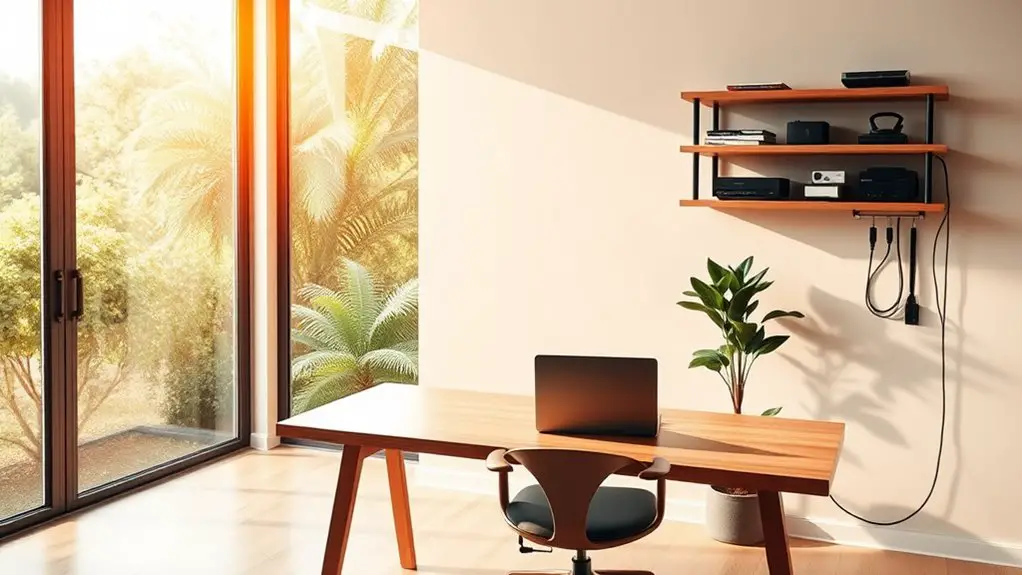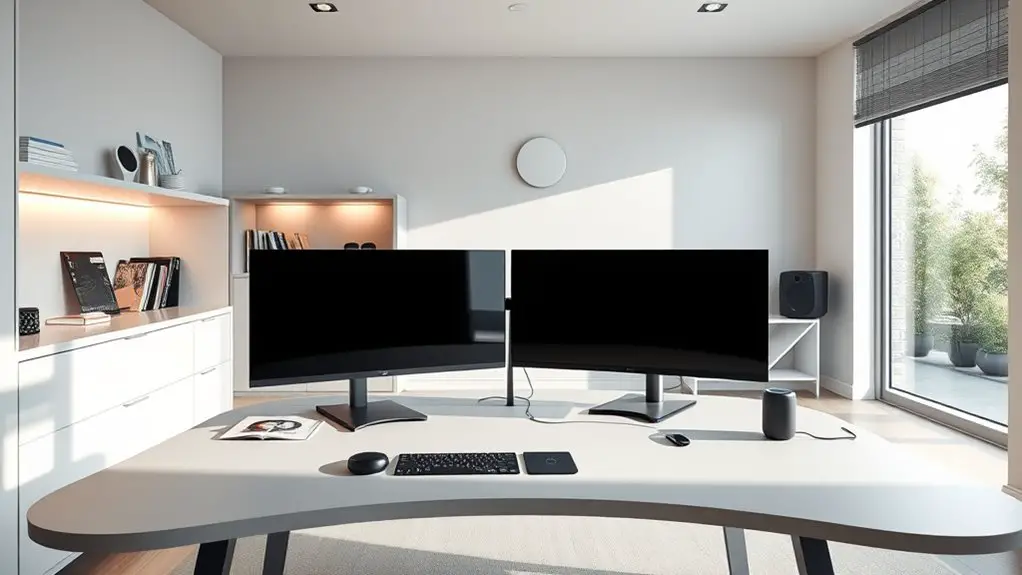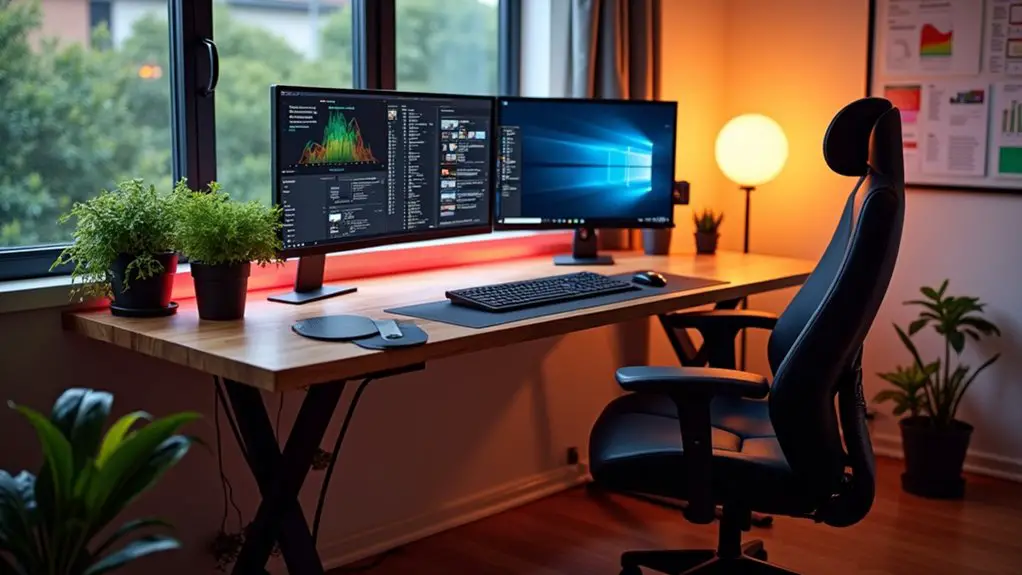To future-proof your home office for tech changes, start by evaluating your current setup and optimizing for comfort and productivity. Invest in ergonomic and modular furniture that adapts to your needs. Upgrade your technology with faster devices and reliable connectivity. Implement smart home solutions for efficiency and organization. Incorporate cable management to reduce clutter. Focus on designing a flexible space that inspires you. Discover strategies that can enhance your workspace even further!
Table of Contents
Key Takeaways
- Invest in modular furniture that can be easily adapted to accommodate new technology and changing workspace needs over time.
- Upgrade to high-speed internet and modern routers to support increased connectivity demands and multiple devices efficiently.
- Choose devices and peripherals with future-proof features, such as compatibility with the latest software and connectivity standards.
- Implement smart solutions for automation, energy management, and security to keep pace with evolving tech trends and enhance productivity.
- Stay informed about industry trends and emerging technologies through reputable sources to ensure your setup remains relevant and efficient.
Assess Your Current Setup

Before you can future-proof your home office, you need to take a hard look at your current setup.
Start by evaluating your workspace—consider the layout, lighting, and organization. Is your desk cluttered? Does your chair support long hours of work?
Evaluate your workspace by examining the layout, lighting, and organization to ensure comfort and productivity.
Next, assess your technology. Are your devices outdated or slow? Check your internet speed; a reliable connection is essential for productivity.
Note any distractions in your environment, like noise or interruptions. Think about your power sources, too. Are they easily accessible?
Finally, take stock of your storage solutions. Are they adequate for your needs?
Invest in Ergonomic Furniture
While setting up your home office, investing in ergonomic furniture is crucial for maintaining comfort and productivity. Choosing the right furniture can greatly reduce strain on your body during long hours of work.
Here's a quick overview of key ergonomic furniture options:
| Furniture Type | Benefits | Considerations |
|---|---|---|
| Ergonomic Chair | Supports posture, reduces back pain | Adjustable height and lumbar support |
| Sit-Stand Desk | Promotes movement, reduces sedentary time | Verify proper height for both sitting and standing |
| Keyboard Tray | Encourages natural wrist position | Should fit your desk setup comfortably |
Embrace Modular Design

To create a versatile home office, you should embrace modular design.
By choosing flexible furniture solutions and adaptable workstation layouts, you can easily adjust your space to meet your changing needs.
Plus, integrating easily upgradable technology guarantees your setup stays current for years to come.
Flexible Furniture Solutions
As you design your home office, embracing modular furniture solutions can transform your workspace into a versatile haven.
Modular furniture allows you to adapt your setup easily, whether you need extra seating for meetings or a larger desk for projects. Look for pieces that can be rearranged or expanded, like desks with interchangeable components or shelving units that can be stacked or separated.
These flexible solutions let you customize your space according to your needs, enhancing both functionality and aesthetics. Additionally, consider furniture that serves multiple purposes, such as a storage ottoman that doubles as extra seating.
Adaptable Workstation Layouts
Creating an adaptable workstation layout is essential for maximizing productivity and comfort in your home office. Start by choosing modular furniture that can easily be rearranged to suit your tasks. A desk on wheels allows you to shift it for better lighting or collaboration with others.
Use stackable or foldable chairs to save space when they're not needed. Incorporate adjustable shelving to accommodate different equipment and supplies as your needs evolve. Organize cables with clips or trays to maintain a tidy appearance.
Keep your workspace flexible by designating areas for specific tasks, like a focused zone for deep work and a collaborative space for brainstorming. This approach guarantees your home office remains functional and inviting, no matter how your work demands change.
Easily Upgradable Technology
Investing in easily upgradable technology is key to keeping your home office relevant as your work evolves. Focus on modular designs for your equipment.
For instance, choose laptops with expandable RAM or storage, allowing you to boost performance without replacing the entire device. Opt for peripherals like keyboards and mice that you can easily swap out or upgrade as needed.
Consider a monitor that supports different mounting options, letting you adjust your setup as your needs change.
By selecting hardware that's designed for upgrades, you'll save money and reduce e-waste in the long run. This approach not only enhances your productivity but also guarantees your tech remains aligned with industry advancements.
Embrace flexibility and make your home office future-ready!
Upgrade Your Technology

Upgrading your technology can greatly enhance your productivity and comfort in a home office. Start by investing in a faster computer or laptop, ensuring you can handle multitasking with ease. Next, consider upgrading your monitor for better visibility and reduced eye strain. High-quality peripherals, like a mechanical keyboard and ergonomic mouse, can also improve your efficiency.
Here's a quick comparison of essential upgrades:
| Upgrade Type | Benefits | Estimated Cost |
|---|---|---|
| Computer | Faster performance | $800 – $2000 |
| Monitor | Improved clarity | $200 – $800 |
| Keyboard | Enhanced typing experience | $50 – $200 |
| Mouse | Ergonomic support | $20 – $100 |
| Headset | Better communication | $30 – $300 |
These upgrades can notably impact your daily workflow.
Implement Smart Home Solutions
To truly future-proof your home office, consider implementing smart home solutions that can automate routine tasks, enhance security features, and improve energy efficiency.
With the right technology, you can streamline your daily operations and keep your workspace secure.
Let's explore how these innovations can transform your home office experience.
Automate Routine Tasks
As you set up your home office, consider how smart home solutions can simplify daily tasks and enhance your productivity. Automating routine tasks can free up time and mental energy for more important projects.
Start with smart lighting; set schedules or control them via voice commands to create the perfect working environment. Smart thermostats can adjust temperatures automatically, ensuring comfort without manual effort. You can also incorporate smart plugs to manage devices remotely, turning them on or off as needed.
For your schedule, use a smart assistant to manage appointments and reminders, keeping you organized. By implementing these technologies, you'll streamline your workflow, reduce distractions, and create an efficient workspace tailored to your needs.
Embrace automation and watch your productivity soar!
Enhance Security Features
While setting up your home office, enhancing security features should be a top priority. Protecting your work and personal information is essential, so consider implementing smart home solutions.
Here are some effective options:
- Smart Locks: Upgrade to keyless entry systems to control access to your office.
- Security Cameras: Install smart cameras that allow you to monitor your space remotely.
- Alarm Systems: Use smart alarms that send alerts directly to your smartphone if triggered.
- VPN Services: Secure your internet connection with a Virtual Private Network to protect sensitive data.
Improve Energy Efficiency
Energy efficiency is essential in a home office, not only for reducing utility bills but also for minimizing your carbon footprint. Implementing smart home solutions can greatly enhance your office's energy efficiency. Smart thermostats, energy-efficient lighting, and programmable power strips help you manage energy usage effectively.
Here's a quick comparison of smart solutions:
| Smart Solution | Benefits |
|---|---|
| Smart Thermostats | Optimize heating/cooling usage |
| LED Smart Bulbs | Reduce energy consumption |
| Programmable Power Strips | Control device energy use |
| Smart Plugs | Schedule on/off times |
Optimize Your Internet Connectivity
To guarantee seamless productivity in your home office, optimizing your internet connectivity is essential. A strong, reliable connection can make all the difference in your workflow.
Here are four key steps you can take to enhance your internet experience:
- Upgrade Your Router: Invest in a modern router that supports the latest standards for better speed and range.
- Position it Well: Place your router in a central location to minimize dead zones and maximize coverage.
- Use Wired Connections: Whenever possible, connect your devices directly to the router with an Ethernet cable for faster speeds.
- Limit Bandwidth Usage: Manage devices and applications that consume bandwidth to prevent slowdowns during important tasks.
Create a Dedicated Power Management System
Creating a dedicated power management system can greatly enhance your home office's efficiency, guaranteeing you stay focused and productive. Start by identifying all your devices and their power requirements.
Invest in a quality surge protector to safeguard your tech from voltage spikes. Consider using smart plugs for added control, allowing you to schedule devices and monitor energy usage.
Label your cords to make it easy to identify which device belongs to which outlet. This not only simplifies your setup but also helps prevent accidental unplugging.
Finally, make certain your power sources are easily accessible, so you can quickly charge devices and avoid the frustration of tangled cords. A solid power management system keeps your workspace organized and your tech running smoothly.
Incorporate Cable Management Solutions
A well-organized workspace isn't just about power management; it also involves effective cable management. Keeping your cables tidy not only improves your office's aesthetics but also prevents accidents and makes maintenance easier.
Here are some simple solutions you can implement:
- Cable Clips: Use adhesive clips to route cables along desk edges and walls.
- Cable Sleeves: Bundle multiple cables together to minimize clutter and tangling.
- Cable Boxes: Hide power strips and excess cords in decorative boxes for a clean look.
- Under-Desk Trays: Install trays underneath your desk to keep cables off the floor and out of sight.
Design for Flexibility and Adaptability
To create a home office that evolves with your needs, consider modular furniture solutions that can change layouts easily.
Incorporating adjustable technology guarantees your space stays functional as your work requirements shift.
This flexibility helps you maintain productivity and comfort, no matter how your work life changes.
Modular Furniture Solutions
As you navigate the evolving landscape of remote work, modular furniture solutions can transform your home office into a flexible and adaptable space.
These versatile pieces allow you to customize your setup according to your needs. Here's how you can benefit from modular furniture:
- Reconfigurable Design: Easily rearrange your workspace to suit different tasks or moods.
- Space Optimization: Use multifunctional pieces that save space while providing necessary functionality.
- Scalability: Expand your office as your needs grow without needing a complete overhaul.
- Aesthetics: Choose from various styles and colors to create an inspiring environment.
Adjustable Technology Integration
While you might already have a solid setup for your home office, integrating adjustable technology can elevate your workspace's functionality and comfort.
Consider investing in height-adjustable desks and monitor stands. These allow you to switch between sitting and standing, promoting better posture and reducing fatigue.
Incorporate adjustable lighting solutions, like smart bulbs or dimmable fixtures, to create the perfect ambiance for any task.
Don't forget about cable management systems; they keep your space organized and clutter-free.
Look for wireless charging stations that can adapt to your devices, eliminating the hassle of tangled cords.
Stay Informed on Industry Trends
Staying informed on industry trends is essential for creating a home office that adapts to changing demands. By keeping your finger on the pulse of technology, you can guarantee your workspace remains efficient and effective.
Staying updated on industry trends ensures your home office evolves with technology, maintaining efficiency and effectiveness.
Here are a few ways to stay updated:
- Follow Tech Blogs: Subscribe to reputable technology blogs to get the latest insights and product reviews.
- Join Online Communities: Engage with forums and social media groups focused on home office setups and tech innovations.
- Attend Webinars: Participate in online events and webinars that discuss emerging trends and tools in the workspace.
- Subscribe to Newsletters: Sign up for newsletters from industry leaders to receive curated content directly to your inbox.
Personalize Your Space for Inspiration
A well-personalized workspace can greatly boost your creativity and motivation. Start by adding elements that reflect your personality—think artwork, photos, or quotes that inspire you.
Choose a color scheme that energizes you; bright colors can invigorate, while soft tones can promote calm. Incorporate functional decor, like unique organizers or stylish storage solutions, to keep your space tidy and visually appealing.
Don't forget about comfort! Invest in a chair that supports your posture and a desk that suits your workflow.
Personal touches, like plants or a favorite mug, can also create a welcoming atmosphere. Ultimately, your home office should be a space that sparks joy and productivity, making it a place you love to work in every day.
Frequently Asked Questions
How Often Should I Reassess My Home Office Setup?
You should reassess your home office setup every six months. This regular check guarantees your workspace meets your evolving needs, incorporates new tech, and maintains comfort and efficiency, allowing you to stay productive and focused.
What Budget Should I Allocate for Ergonomic Furniture?
You should allocate around 20% of your home office budget to ergonomic furniture. Investing in a quality chair and adjustable desk enhances comfort and productivity, ensuring you maintain a healthy workspace for long-term success.
Can I Use Modular Furniture in Small Spaces?
Absolutely, you can use modular furniture in small spaces! It's versatile and can adapt to your needs. You'll find it maximizes functionality while keeping your area open and organized, enhancing both comfort and efficiency.
How Can I Ensure My Wi-Fi Signals Reach All Areas?
To guarantee your Wi-Fi signals reach all areas, position your router centrally, use Wi-Fi extenders or mesh systems, and minimize obstructions like walls. Regularly update your router's firmware for peak performance and security.
What Are the Benefits of Smart Home Solutions for a Home Office?
Smart home solutions enhance your home office by improving convenience, efficiency, and comfort. They automate tasks, optimize energy usage, and create a more adaptable workspace, allowing you to focus better and boost productivity effortlessly.




